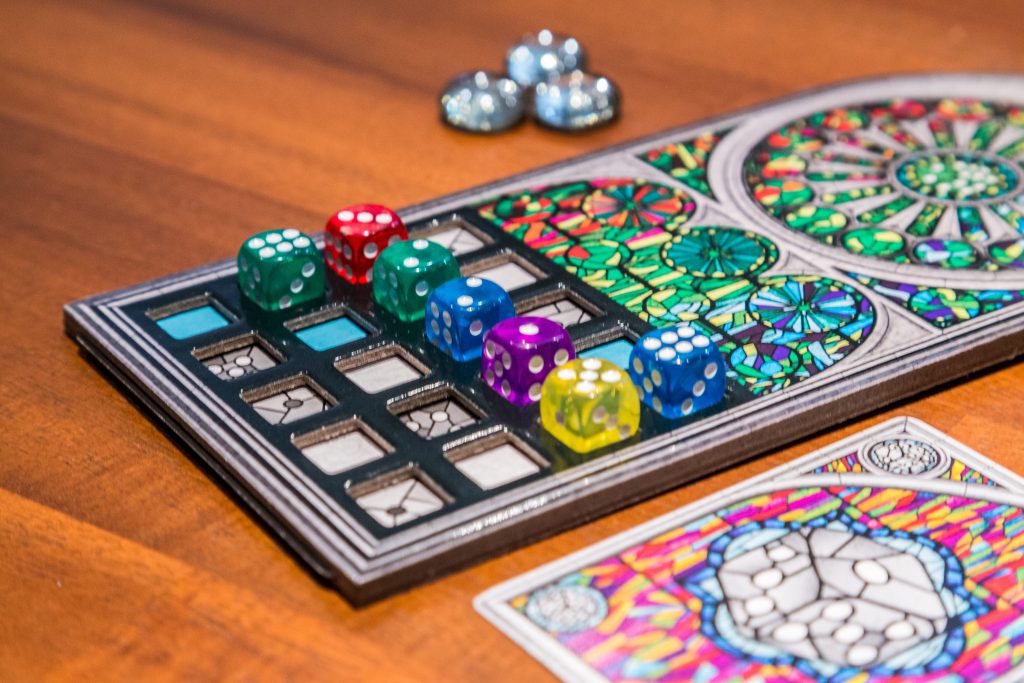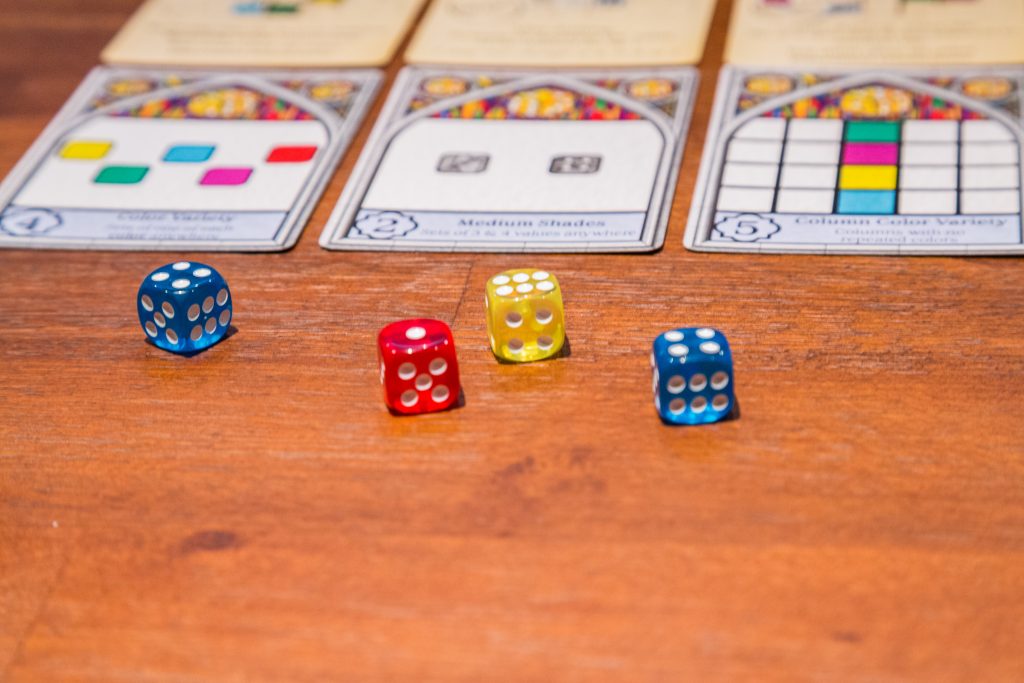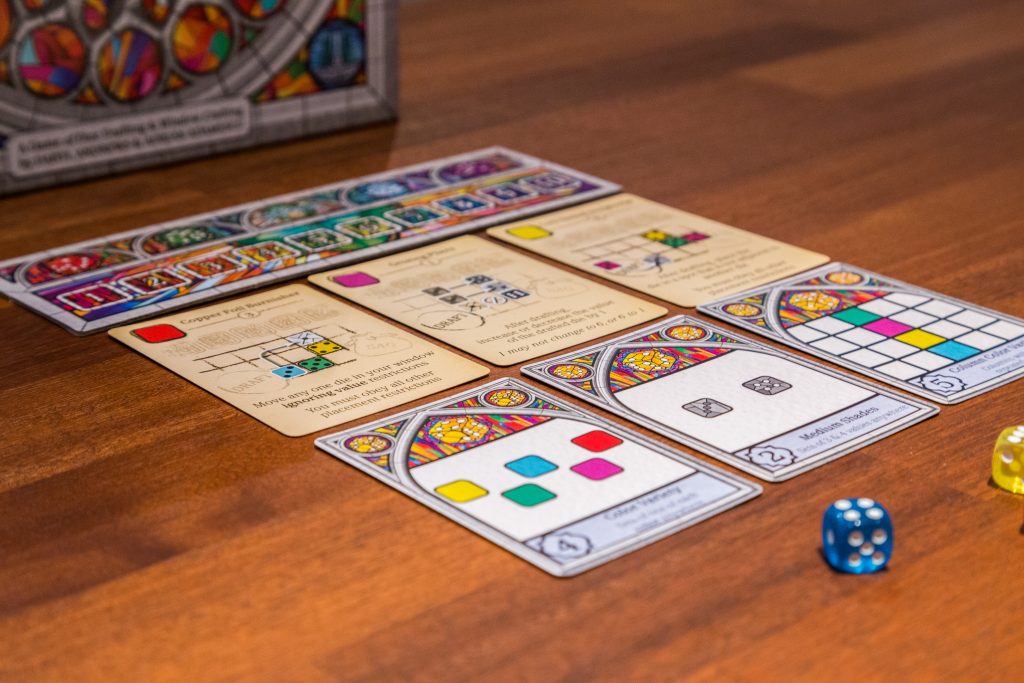 In Sagrada from Floodgate Games, you draft and manipulate dice as an artisan tasked with the planning and construction of a stained glass masterpiece in the Sagrada Familia. This beautiful game by Daryl Andrews and Adrian Adamescu can be played in as little as 20-30 minutes with 2 players and no more than an hour with 4. Sagrada has instantly become a game that I turn to when I want a quick yet strategic challenge that offers me meaningful choices and is a whole lot of fun.
In Sagrada from Floodgate Games, you draft and manipulate dice as an artisan tasked with the planning and construction of a stained glass masterpiece in the Sagrada Familia. This beautiful game by Daryl Andrews and Adrian Adamescu can be played in as little as 20-30 minutes with 2 players and no more than an hour with 4. Sagrada has instantly become a game that I turn to when I want a quick yet strategic challenge that offers me meaningful choices and is a whole lot of fun.
ARTWORK AND COMPONENTS
Sagrada’s artwork and components are bright and colourful. The theme of building a stained glass window provides great opportunities for colourful visuals throughout. The player boards are sturdy, clever and fun to use. My only gripe with them is that the dice holes seemed a bit too shallow. The amount of times you’ll want to pick up your own dice to re-check limitations underneath is actually quick significant. I often knocked dice off the board or accidentally flipped dice to completely different numbers and then forgot what they previously were. If you’re careful, this is mostly a non-issue, but it happened to me more than once.
The theme itself in Sagrada, while appropriate and visually pleasing, is obviously not the most exciting. Without any prior knowledge, one might overlook this game on the shelf, especially next to other options with far more exciting themes. A game like Jaipur, for instance, suffers from this too. However, the theme works well for the game and has a lot of substance behind it. The most striking feature about the artwork and the components is just how vibrant they are. Once you have this game out of the box and on the table, it really pops. There may not be a ton of variety in the artwork and it is not overly memorable in comparison to other games in my collection, but Sagrada is one of the more eye-catching and colourful games you’ll be playing.
One note worth mentioning, as it may affect some people, is that this game relies heavily on colour differentiation. As such, those who are colour blind may find this to be a very difficult, if not impossible, game to play effectively or to have a good time with. I’m not sure there is an easy or straightforward fix they could have implemented for this, but something to keep in mind before purchasing.

Sagrada is a very colourful, eye-pleasing board game.
DESIGN
Sagrada is a pretty unique experience, relative to other games I’ve played. The closest comparison that comes to mind would be Dice City, but the similarities are mainly in your ability to manipulate dice to meet goals.
Sagrada cleverly allows you to tailor your experience based on how difficult a challenge you want, by giving you a selection of four possible window panes to choose from each game. Each window pane has its difficulty conveniently located in the corner, meaning that your specific complexity tastes are all catered to. You won’t be at a disadvantage for choosing a more difficult pane, nor will you be at an advantage for choosing an easier one. The game balances your decision by netting you with differing amounts of favour tokens, which allow you to alter die faces, move dice around, re-roll them and a host of other abilities. While straightforward in nature and execution, it’s a smart design decision that makes an already accessible game even more accessible.
Here lies the bulk of the strategy in Sagrada. Throughout my many playthroughs, I was able to sample a range of different window cards of varying difficulty levels and I never once felt frustrated or annoyed by the restrictions imposed on me, nor did I ever feel they were too lenient. A lot of the fun came from knowing that there must be a solution; some way to use a combination of the tools available, the dice available and my problem solving to score the most points possible.
It felt like the perfect game to play with a significant other or on a rainy afternoon at the cabin.
That being said, as the game goes on and your board has only a couple unfilled spaces, the room for strategy and decision-making dwindles. Although there were instances where last minute tool usage or dice maneuvering led to reshaping my board for maximum points, usually the final couple turns amounted to desperately trying to fit the available dice into the remaining spots. While this is a different kind of strategy altogether and was still rewarding when I figured it out, I sometimes felt that the final turns were “playing themselves”. At times, for instance, I simply needed a blue die or a 3 and I spent my final two turns watching the dice roll, crossing my fingers for what I needed.
Mechanically, Sagrada is pretty relaxing. There aren’t a ton of opportunities for “Take that!” moments, and trying to keep track of your opponent’s board can be pretty difficult. In fact, unless the person is sitting beside you or you’re at a smaller table, you might find it hard to even see your opponent’s window restrictions. This is definitely not a game to play with someone you don’t trust,  especially in a full 4-player game. Even more notably, keeping track of your opponent’s mistakes is not easy.
especially in a full 4-player game. Even more notably, keeping track of your opponent’s mistakes is not easy.
Overall, the player interaction in Sagrada, in my experience, tends to be pretty minimal. This isn’t a bad thing for this type of game. I found it refreshing and it felt like the perfect game to play with a significant other or on a rainy afternoon at the cabin. You’ll spend most of your time focusing on your own board and own moves, only being influenced by your opponent when they happen to take one of the dice you were hoping to draft.
FUN FACTOR
I had a lot of fun playing Sagrada. Especially in 2-player matchups, the fact that the games were incredibly quick, but still filled with problem solving and strategy, always made the experiences feel rewarding and winnable. There is also room for a ton of variety and I could see playing many games before ever feeling like you had two the same.
Sagrada comes with a deck of public objectives, a deck of private objectives and a deck of tool cards and you’ll have a new combination of these to work with each game. This makes for a wild amount of potential combinations, where one game you’ll find yourself trying to fill your board with sets of colours and another you’ll find yourself making multiple pairs of numbers. The variety here reminded me a lot of Kingdom Builder, where I still have yet to play two overly similar rounds.
Tool usage leads to some of the most satisfying turns and overall decision-making, but your mileage with this element will also vary on the player count and number of favour tokens in play. For example, 2-player games provide more opportunities for tool usage and even repeated usage of the same tool. However, in a 4-player game, it definitely feels slightly more cutthroat and tools tend to be harder to use, especially more than once. The price of tools increases much quicker and if you only take a level 3 difficulty window card, you might find yourself out of the running for most tools fairly quickly.
The most important thing to note about Sagrada, however, is this: it’s fun.
There isn’t much downtime in Sagrada, which helps contribute to its quick pace. Even with 4 players, I spent other players’ turns keeping an eye on the dice that were chosen and scanning my board for placement possibilities based on what was unfolding. In fact, the selecting of dice happened so quickly sometimes that I often found myself even wishing I had a bit more downtime to properly plan my next move.
One minor concern with the way Sagrada played came from the scoring. I noticed that in a lot of the games I played, the majority of each player’s points came from adding up dice for the private objectives. Generally, this would often decide the winner. While this didn’t detract from my enjoyment or ruin the experience, it did somewhat cheapen the value of the public objectives, which is a shame because they are far more interesting than the private ones. The private objectives are all about adding up the totals of a specific colour of dice on your board, whereas the public objectives have a whole slew of ways for you to configure your own board to try and maximize your points. Achieving a high score too often seemed to come down to picking all the highest value dice of the colour represented in your private objective, rather than getting creative on your board.

There’s a lot of variety to be had with public objectives, private objectives and tool cards.
The most important thing to note about Sagrada, however, is this: it’s fun. I had a great time playing it and the games moved at such a great pace and had just the right amount of strategy for a light game. It played well at all player counts and every game truly felt just different enough to make me want to play again. Also, the majority of the games I played were very close. Blowouts were uncommon which made it an exciting challenge.
Sagrada does boast a solo mode and while it does a great job of translating the core concepts and principles into a solo environment, I didn’t feel like the game was nearly as fun when played solo. Something I enjoyed about playing Sagrada with 2-4 players was that even though the game heavily uses dice, it never felt too overly luck based. In solo mode, that’s no longer the case and luck will play a huge factor in your results. If you’re constantly rolling several 5s and 6s, the score you’re going to need to beat will quickly become unreachable in a lot of situations. Especially when playing on higher difficulties of the solo mode where you only have 1 or 2 tools to utilize. I did appreciate the fact that Sagrada provided you with multiple difficulty levels to try and cater your solo experience to your liking. However, I was never able to find that sweet spot. With only 2 tools, I was able to win 1 in every 3 games or so, depending on how the dice and colours treated me. Whereas with 1 tool, I only won a single game and luck was the overwhelming factor in that result. Overall, I’m happy a solo option is included as being able to scratch an itch for a board game when you might not have people to play with is a very welcome thing, but I don’t think this is a solo mode I would flock back to very often.
VALUE
I’m happy to have Sagrada in my collection, because I know I’ll be coming back to it again and again. It might not be the flagship title on my shelf, but it’s one that comes out on many different occasions due to its versatility and ease of play and learning. It isn’t very expensive and because of how quick it plays, one round will usually turn into a best-of-3 or a best-of-5. Sagrada offers a flexible experience, working wonderfully at all player counts, meaning you won’t feel restricted when it comes to finding time to bring it to the table. And the inclusion of a solo mode, even if it isn’t perfect, is a pleasant addition that only provides further opportunities for this game to hit the table.
VERDICT
Sagrada makes a wonderful addition to anyone’s game collection, offering a fun and relaxing game night. The opportunity for more strategic thinking is there if a player wants it, but it also functions as a simple dice drafting game that doesn’t necessarily have to require a lot of thought. Sagrada is a game I’ll come back to time and time again and I think you might too.
Pros
- Games of Sagrada are quick and don't require a ton of commitment.
- The components and artwork are eye-catching and colourful.
- The interchanging objectives and tools will make most of your sessions seem very different from one another.
Cons
- Public objectives are often overshadowed by private objectives, which are less unique or interesting.
- Players are each mostly "doing their own thing". Not a ton of interaction between players.
- The artwork, while striking, does get a bit repetitive after a while. There isn't a ton of variety between components.
Leave a reply
You must be logged in to post a comment.
